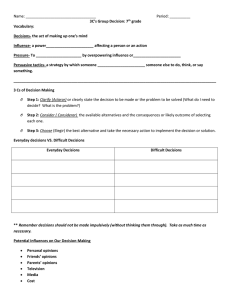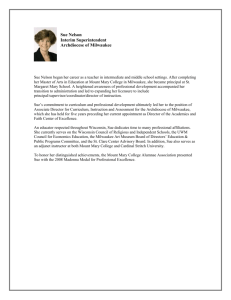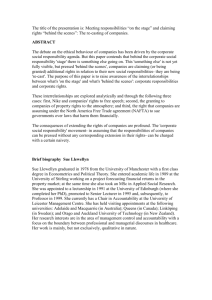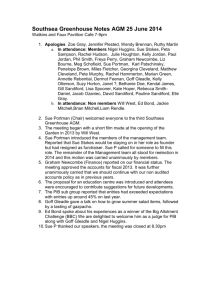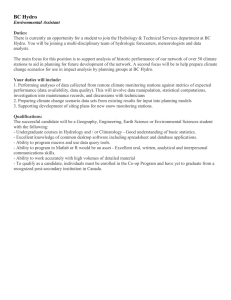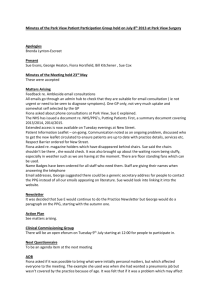Energy efficiency learning never ends in the education sector
advertisement
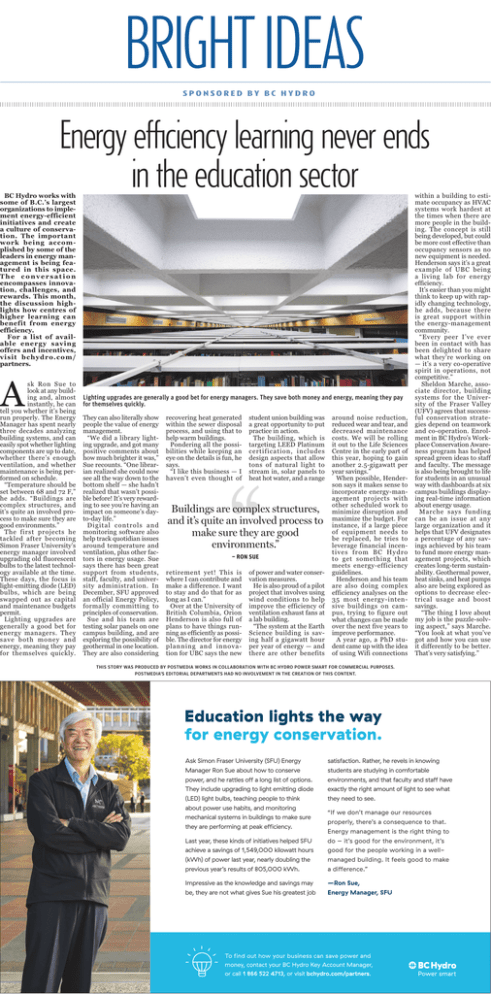
bright ideas sponsored by bc hydro Energy efficiency learning never ends in the education sector BC Hydro works with some of B.C.’s largest organizations to implement energy-efficient initiatives and create a culture of conservation. The important work being accomplished by some of the leaders in energy management is being featured in this space. The conversation encompasses innovation, challenges, and rewards. This month, the discussion highlights how centres of higher learning can benefit from energy efficiency. For a list of available energy saving offers and incentives, visit bchydro.com/ partners. A sk Ron Sue to look at any building and, almost instantly, he can tell you whether it’s being run properly. The Energy Manager has spent nearly three decades analyzing building systems, and can easily spot whether lighting components are up to date, whether there’s enough ventilation, and whether maintenance is being performed on schedule. “Temperature should be set between 68 and 72 F,” he adds. “Buildings are complex structures, and it’s quite an involved process to make sure they are good environments.” The first projects he tackled after becoming Simon Fraser University’s energy manager involved upgrading old fluorescent bulbs to the latest technology available at the time. These days, the focus is light-emitting diode (LED) bulbs, which are being swapped out as capital and maintenance budgets permit. Lighting upgrades are generally a good bet for energy managers. They save both money and energy, meaning they pay for themselves quickly. Lighting upgrades are generally a good bet for energy managers. They save both money and energy, meaning they pay for themselves quickly. They can also literally show people the value of energy management. “We did a library lighting upgrade, and got many positive comments about how much brighter it was,” Sue recounts. “One librarian realized she could now see all the way down to the bottom shelf — she hadn’t realized that wasn’t possible before! It’s very rewarding to see you’re having an impact on someone’s dayto-day life.” Digital controls and monitoring software also help track quotidian issues around temperature and ventilation, plus other factors in energy usage. Sue says there has been great support from students, staff, faculty, and university administration. In December, SFU approved an official Energy Policy, formally committing to principles of conservation. Sue and his team are testing solar panels on one campus building, and are exploring the possibility of geothermal in one location. They are also considering recovering heat generated within the sewer disposal process, and using that to help warm buildings. Pondering all the possibilities while keeping an eye on the details is fun, he says. “I like this business — I haven’t even thought of student union building was a great opportunity to put practice in action. The building, which is targeting LEED Platinum certification, includes design aspects that allow tons of natural light to stream in, solar panels to heat hot water, and a range Buildings are complex structures, and it’s quite an involved process to make sure they are good environments.” – ron sue retirement yet! This is where I can contribute and make a difference. I want to stay and do that for as long as I can.” Over at the University of British Columbia, Orion Henderson is also full of plans to have things running as efficiently as possible. The director for energy planning and innovation for UBC says the new of power and water conservation measures. He is also proud of a pilot project that involves using wind conditions to help improve the efficiency of ventilation exhaust fans at a lab building. “The system at the Earth Science building is saving half a gigawatt hour per year of energy — and there are other benefits around noise reduction, reduced wear and tear, and decreased maintenance costs. We will be rolling it out to the Life Sciences Centre in the early part of this year, hoping to gain another 2.5-gigawatt per year savings.” When possible, Henderson says it makes sense to incorporate energy-management projects with other scheduled work to minimize disruption and maximize the budget. For instance, if a large piece of equipment needs to be replaced, he tries to leverage financial incentives from BC Hydro to get something that meets energy-efficiency guidelines. Henderson and his team are also doing complex efficiency analyses on the 35 most energy-intensive buildings on campus, trying to figure out what changes can be made over the next five years to improve performance. A year ago, a PhD student came up with the idea of using Wifi connections within a building to estimate occupancy as HVAC systems work hardest at the times when there are more people in the building. The concept is still being developed, but could be more cost effective than occupancy sensors as no new equipment is needed. Henderson says it’s a great example of UBC being a living lab for energy efficiency. It’s easier than you might think to keep up with rapidly changing technology, he adds, because there is great support within the energy-management community. “Every peer I’ve ever been in contact with has been delighted to share what they’re working on — it’s a very co-operative spirit in operations, not competitive.” Sheldon Marche, associate director, building systems for the University of the Fraser Valley (UFV) agrees that successful conservation strategies depend on teamwork and co-operation. Enrolment in BC Hydro’s Workplace Conservation Awareness program has helped spread green ideas to staff and faculty. The message is also being brought to life for students in an unusual way with dashboards at six campus buildings displaying real-time information about energy usage. Marche says funding can be an issue at any large organization and it helps that UFV designates a percentage of any savings achieved by his team to fund more energy management projects, which creates long-term sustainability. Geothermal power, heat sinks, and heat pumps also are being explored as options to decrease electrical usage and boost savings. “The thing I love about my job is the puzzle-solving aspect,” says Marche. “You look at what you’ve got and how you can use it differently to be better. That’s very satisfying.” This story was produced by Postmedia Works in collaboration with BC Hydro Power Smart for commercial purposes. Postmedia’s editorial departments had no involvement in the creation of this content. Education lights the way for energy conservation. Ask Simon Fraser University (SFU) Energy Manager Ron Sue about how to conserve power, and he rattles off a long list of options. They include upgrading to light emitting diode (LED) light bulbs, teaching people to think about power use habits, and monitoring mechanical systems in buildings to make sure they are performing at peak efficiency. satisfaction. Rather, he revels in knowing students are studying in comfortable environments, and that faculty and staff have exactly the right amount of light to see what they need to see. Last year, these kinds of initiatives helped SFU achieve a savings of 1,549,000 kilowatt hours (kWh) of power last year, nearly doubling the previous year’s results of 805,000 kWh. “If we don’t manage our resources properly, there’s a consequence to that. Energy management is the right thing to do – it’s good for the environment, it’s good for the people working in a wellmanaged building. It feels good to make a difference.” Impressive as the knowledge and savings may be, they are not what gives Sue his greatest job —Ron Sue, Energy Manager, SFU To find out how your business can save power and money, contact your BC Hydro Key Account Manager, or call 1 866 522 4713, or visit bchydro.com/partners.

